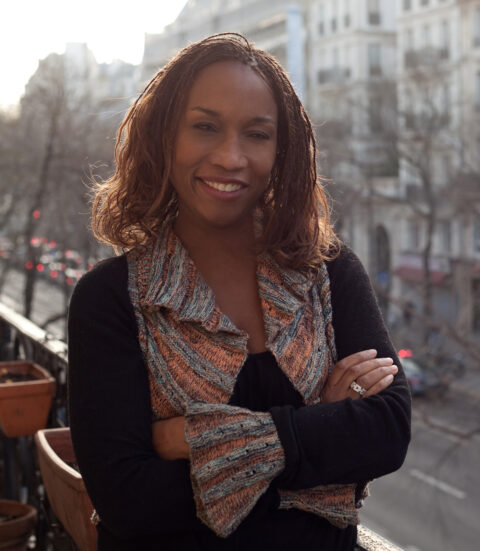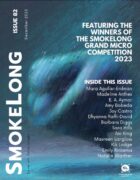“Balance” means so much in your piece—the word acts as action, metaphor, and writing structure. So much of what remains unsaid pushes through the narrative, like the secret flames burning beneath Queenie’s skin, and the unwritten balances perfectly against what is shown. What is your approach to the literal, figurative, conjured balance in your writing?
For me, finding balance is definitely one of the most challenging aspects of writing flash. Because you have to omit so much backstory but still communicate it, gauging whether you’ve gone too far or not far enough is tricky. In this story, finding an equilibrium was a bit easier because I knew that “balance” was at the heart of the story. I could clearly envision how balance might manifest in Queenie’s and her mom’s lives, with books as the central metaphor. Everything else flowed from there.
As for my writing generally, finding balance is an instinctive process, trial and error. Once the basic story structure is in place, I just do the work of experimenting and playing with words and symbols that best bring the unsaid into the room. I also try to keep in mind advice someone in my critique group once gave me: “When the topic’s hot, write cool; when it’s heavy, write light.” That’s good balancing advice, I think.
This story ever so quietly, with such beautiful neutrality, demonstrates the ubiquitous presence of trauma, and how, in difficult situations, it tends to intensify over time. How do you process the trauma inflicted on, or by, your characters?
I’m really bad at making my characters suffer. I always want everyone to be happy and play nice! I have to consciously examine my drafts to see whether I’m holding back and, if so, make myself push the situation further. But now that you ask, I realize that resilience is a recurrent theme in my writing. Queenie and her mom suffer, but it was important to me to have them, especially her mom, fighting tooth-and-nail against the weight bearing down on them. One of my first published stories was about an enslaved woman who was regularly raped by her enslaver. Spending time on this theme made me feel physically ill, but I kept thinking about the vein of strength women who actually lived the experience had to call upon, and that kept me going. So, I guess you could say I process the trauma of my characters by looking for and channeling their inner strength and bringing that to the scene.
Queenie’s mother is a person under pressure, but she passes that along. However well intended, or however involuntarily compulsive, her choices stand alone, without commentary. You simply lay her behavior bare. What role do you feel the writer plays in telling a difficult truth about a character?
Writers owe it to their readers to tell the truth about their characters, but difficult truths are necessarily complex. If the writer shows her hand too much, I think there’s a danger of presenting the truth one-dimensionally. In this story, I hoped that by standing back and letting Queenie’s mom’s larger actions speak for themselves, the fullness of her character and the nature of her relationship with her daughter could better emerge in the quieter details. An absence of direct commentary gives readers the freedom to reflect on and empathize with the characters from their own emotional and experiential perspective. What one person may see as a difficult truth, another may see simply as a truth, and still another may see as an admirable truth.
This is the second publication for this story, a true honor for any single piece. How does the experience differ between having a piece accepted the first time versus seeing it reprinted? Is the celebration as cheery the second time around? How do you celebrate publication?
Oh, I was so thrilled! I mean, it’s SmokeLong! What flash writer doesn’t dream of this honor? Of course, I was also excited and honored when “Balance” was originally published in the Flash Flood Journal in 2021. But it was released on Flash Flood Day along with hundreds of other wonderful micros. I’m delighted the story gets to stand in a larger spotlight.
If you were Queenie, what books would you have chosen to read?
When I was 8, I definitely would have chosen A Wrinkle in Time or A Wind in the Door by Madeline L’Engle. Maybe the Narnia Chronicles. If I were 8 today, I would have gravitated toward fantasies with young Black heroines like the excellent Akata Witch series by Nnedi Okorafor. Or I probably would have tried to read Children of Blood and Bone and ended up scaring myself to death. Lots more literary variety these days–it’s an exciting thought!



 The core workshop of SmokeLong Fitness is all in writing, so you can take part from anywhere at anytime. We are excited about creating a supportive, consistent and structured environment for flash writers to work on their craft in a community. We are thrilled and proud to say that our workshop participants have won, placed, or been listed in every major flash competition. Community works.
The core workshop of SmokeLong Fitness is all in writing, so you can take part from anywhere at anytime. We are excited about creating a supportive, consistent and structured environment for flash writers to work on their craft in a community. We are thrilled and proud to say that our workshop participants have won, placed, or been listed in every major flash competition. Community works.